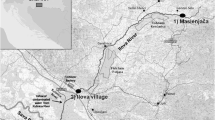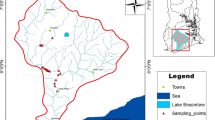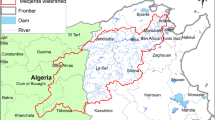Abstract
The water and bed-sediment pollution status of the Padma River was determined by analysis of representative samples for selected metals and ions. Water and bed-sediment samples were collected at a T-dam, Rajshahi, Bangladesh, for 7 months. Water and silt-metal content analysis was performed using atomic absorption spectrophotometry or other analytical methods. The data showed the variation of the metal ion-levels in water as follows: Ca 17.11–48.37 ppm, Na 17.51–20.09 ppm, K 1.00–3.60 ppm, Cr 2.80–7.00 ppm, and SO4 4.17–5.48 ppm; in bed sediment, the levels were Cr 35–1050 ppm and Pb 12–48 ppm. The occurrence of Na, K and Ca was in the normal range (US EPA permissible limit), but the levels of Cr in water were much higher than the permissible limit. The SO4 ion content was well below the pollution level. The concentration of Pb in the bed sediment was within the permissible limit for the standard International Atomic Energy Agency (IAEA) Soil-5a, but the concentration of Cr in the bed sediment was significantly higher than the permissible limit for the standard IAEA Soil-5a. Thus the Padma river water was polluted with Cr. The occurrence of some ions showed a monthly variation.
Similar content being viewed by others
Author information
Authors and Affiliations
Additional information
Received: 19 August 1999 · Accepted: 12 October 1999
Rights and permissions
About this article
Cite this article
Zereen, F., Islam, F., Habib, M. et al. Inorganic pollutants in the Padma River, Bangladesh. Environmental Geology 39, 1059–1062 (2000). https://doi.org/10.1007/s002549900098
Issue Date:
DOI: https://doi.org/10.1007/s002549900098




